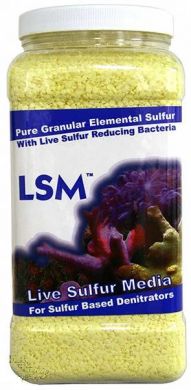L.S.M. Live Sulfur Media 3.8l
L.S.M. Live Sulfur Media 3.8l
SKU:SKU L.S.M. Live Sulfur Media 3.8L
L.S.M. Live Sulfur Media 3.8L
Here is a pure granular elemental sulfur, with sulfur reducing bacteria right on it. This product can be used in a number of ways, and accomplishes the same job of nitrate reduction as our NO-NO3®. This product is ideal for dual chamber reactors, using our A.R.M.® in one reactor and placing the L.S.M.® in another. This results in a system that delivers elevated calcium, and reduced nitrates.
Directions
LSM™ is intended for use in experimental sulfur based nitrate reduction equipment or systems. Nitrate and pH test kits are required to fine tune any nitrate reducing equipment. Sulfur based nitrate reducing bacteria require an oxygen depleted environment. Be aware that this process may strongly acidify surrounding water. A typical system employs two separate canisters with a means to control water flow rate through the reactor. The first canister contains the LSM™. The second canister is filled with aragonite to neutralize acidified water and supply calcium ions as a by-product of neutralization. LSM™ can be placed in any oxygen restricted environment. As with any experimental project, we do not recommend putting a significant amount of sea life at immediate risk, nor risk the health of well established systems without a thorough testing of the effluent parameters first.
Note: Nitrate reduction with sulfur may produce an odor. Due to the experimental nature of sulfur based de-nitrification, the manufacturer accepts no responsibility for the use of this product.
Guidelines for LSMTM Use in Reactors and Modified Jaubert Systems:
The most common application for LSMTM would, of course, be in reaction chambers. Before going into the details here’s a review of the basic concept of autotrophic sulfur denitrification:
In the reactor, sulfur is a food source for bacteria that also eliminate nitrates by converting them to Nitrogen gas. In time the bacteria break down the elemental sulfur and also create sulphate and hydrogen. Both of these by-products can have a negative impact on pH, by bringing the pH down, so it is important to make sure that the effluent from any sulfur reactor is adjusted back to a pH that is acceptable for a marine system.
The most useful reactor designs have a two chamber design with the first chamber holding the sulfur media and performing the denitrification, while the second chamber is filled with calcium reactor media and adjusts the pH of the effluent back to acceptable levels.
Flow rates:
Because autotrophic bacteria will prefer oxygen over nitrate because of this it is important for the flow through the reactor to be slow enough to deplete oxygen so that it is not present for some length of the column. It should also be noted that design is simplified by having a vertical reactor with water added to the bottom so that the sulfur stays in the reactor as it will have a tendency to crumble as it is consumed.
Initial flow rates tend to be in the 1 liter per hour per liter of sulfur in the reactor. Rates may be adjusted up to about 5 liters per hour ultimately but initially should even be below 1 liter.
Because of the slow flow rates, the calcium reactor media may clog as it breaks down too. A coarse grade reactor media will eliminate this possibility. By following these few, loose guidelines a very simple sulfur reactor can be created.
Volume of reactor:
The volume of the Sulfur reactor should be about 1% the volume of the system if the NO3 levels are below 50 mg/l or 2% in systems where the initial concentration is greater than 50 mg/l.
Modified Jaubert sulfur use:
The use of sulfur in a Jaubert or deep sand bed, (DSB), system is even simpler but may not necessarily always be as successful so care should be taken when considering this usage. The product NO NO3TM may be a safer alternative for this type of use as it is tempered a bit by having aragonite mixed with the sulfur beads. In both system types a sulfur media is the bottom substrate, (at the depth of about ½”), either above the plenum or on the tank bottom.
FAQ:
In what type of reactor would I use LSM™?
LSM™ is meant to be used in dual chamber, (or sandwich style single chamber), slow flow, media reactors designed for denitrifying with elemental sulfur. Typically LSM™ is used with ARM™ directly after it to adjust the pH back to sea water parameters. For more information see “Guidelines for the Use of LSM™ in Reactors and Modified Jaubert Systems” in LSM™ Directions.
How does LSM™ work?
LSM™ is a nitrate reducing media for use in low flow sulfur reactors. Bacteria that are on the LSM™ consume elemental sulfur. To do this they need a source of either O2 or NO3. By placing the LSM™ in a slow flow chamber the O2 becomes depleted in the very beginning of the chamber allowing NO3 to be used to complete the digestion of the sulfur in the remainder, (majority), of the chamber. This reduces the NO3 to nitrogen gas and eliminates it from the system
Couldn't load pickup availability
Reviews

Reviews
Specifications

Specifications
Shipping and Returns

Shipping and Returns











